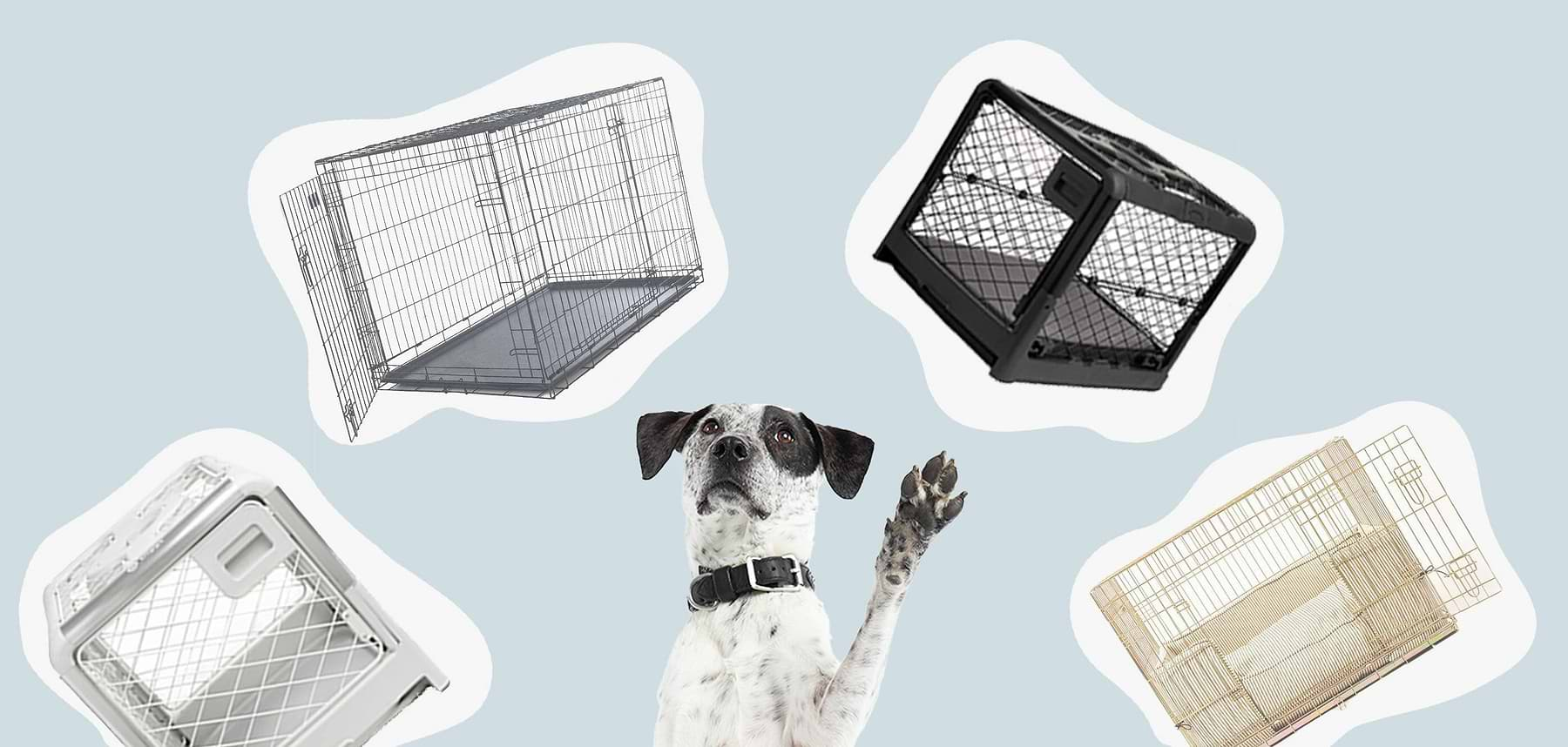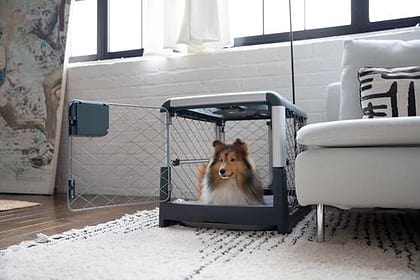
There are many benefits to crate training, from easier potty training to giving your dog a den to call their own. When you can’t be around to supervise your pup, a crate can keep both your dog safe from danger and your house safe from your dog. Plus, crates can be useful when you’re traveling with your pet.
Dogs are denning animals and appreciate having a cozy area to settle down and relax in. If you train your dog properly, they will love their crate. It’s not a cage! It’s your dog’s private space where they can feel cozy and secure.
With so many reasons to purchase a crate for your pup, it should be at the top of your shopping list. But, there are so many options and it can be tricky to know where to start. Cloth, wire, plastic, or wood? What features should you be looking for? We feel your pain! That’s why we made this primer on choosing the perfect crate. We can help you make the right match for you and your dog’s needs.
How will you use the crate?
One of the very first things you will want to consider is how you will be using the crate and what it will offer your dog. For example, a wire crate has better air circulation than a plastic one. A fabric crate might be too easy for your dog to chew through. Decide on how you plan to use the crate and consider what that entails. A crate used for taking your dog back and forth to the vet will require different features than a crate used for potty training.
You should also consider your dog’s behavior and habits. Are they a heavy chewer? Do they get anxious from too much stimulation? Do they try to escape from confinement? Remember, this is supposed to be their den. Just like your bedroom, your pup’s crate should reflect their preferences and personality. Also, if your puppy is still growing, consider a crate that you can resize with a divider panel so you don’t have to buy a new crate once they reach adulthood.
Once you’ve assessed both your needs and your dog’s, you’re ready to research different crates and pick the right one for your situation. Here are some considerations that should go into your choice of crate.
What materials are available?
Crates come in a wide variety of materials. Metal crates are the most popular design and are made of wire mesh panels. Plastic crates, sometimes called airline kennels, are usually made of two durable plastic halves that fasten together with a metal door in the front. Fabric or soft-sided crates often have metal frames with cloth panels and a zippered cloth door. If you want your dog’s crate to be a permanent fixture in one room of your house, then you might want to consider a wooden or furniture crate. These are wire crates that incorporate wood into the design, such as wooden tops or side beams. They blend into your furniture and can double as a side table.
How does the crate prioritize safety?
There are two elements to crate safety. First, the crate should keep your dog safely inside and they shouldn’t be able to escape. We know there are doggie Houdinis out there who will try to get out of any confinement, so if your dog is an escape artist, look for a crate with secure panels and a dog-proof lock on the door. Second, your dog should be safe inside the crate. Unfortunately, some poorly-designed crates have potentially harmful features, like metal bars that your dog may try to chew or panels that they could get their paw stuck in.
Metal crates are the easiest for dogs to escape from. By pushing on the panels, they can pop them open and squeeze through the resulting opening. And, of course, that can lead to destruction in your house, or even worse, injury to your pup. Dogs can also damage their teeth by chewing on the bars or get their jaw stuck in the wire mesh. If a wire crate meets all your other needs, but your dog is a power chewer or you suspect they will attempt to escape, search for a heavy-duty version that can weather even your dog’s best efforts.
Furniture crates pose some of the same risks as they are made of metal mesh panels with a partially wooden frame. Keep in mind that wood is an appealing chewing material for some dogs, particularly teething puppies. Not only will that ruin the look of your expensive crate, but wood splinters can injure your pup.
For the determined dog, fabric crates can also be too easy to escape from. They aren’t particularly durable, as dogs can chew or scratch their way through the cloth. Pups are less likely to be able to escape from metal or plastic crates. Look for a durable version that can take wear and tear.
No matter what style of crate you choose, there’s one safety tip we want to share for all crated dogs: crated dogs should be naked! Never place your dog in their crate with their collar or harness on. The clasp or ID tags can get caught in the bars or between the panels, which poses a strangulation risk. If you must use a collar, we recommend a break-away style (with embroidered ID information or a lay-flat tag) that will snap off if it gets caught.
Is it easy to use?
Another thing to consider is whether you will be moving your dog’s crate around your home or in and out of your car. Will you be storing it in between uses? A crate that’s easy to take down and reassemble might be an important feature for your family depending on your needs. Also, think about where you’ll want to put the crate. Do you need multiple doors so your dog can access it no matter where you locate it? A top door can also be useful for placing toys and treats in the crate without your dog being able to wiggle out. And finally, is your puppy still growing? If their crate is too big, it can impede potty training. If you only want to buy one adult-sized crate, choose one with a divider panel so that the crate will “grow” with your pup.
Metal crates aren’t always the easiest to assemble, but they are great for storage as many models fold flat. Plus, they also often come with divider panels to accommodate your puppy’s growing need for space. However, they can be heavy and awkward to move around. A plastic crate is simpler to assemble and lighter to move around the house, but might require more room for storage. Fabric crates also fold away for easy storage and are lightweight making them easy to carry. They also are quick to assemble. Finally, furniture crates are not meant to be stored or moved about as they double as furniture. We recommend taking some time to assess your needs and considering which factors are most important for your situation.
Does it provide ventilation and privacy?
Your dog’s personality will play a big role in the amount of privacy they need. Some pups love to see the world around them, whereas others will feel more comfy and secure with less light and less visibility. The flip side to privacy is ventilation—the more open the crate, the more airflow.
Metal crates have great visibility and airflow which might be just what your dog needs. But if your dog is anxious about seeing the world go by, a crate cover can help provide that sense of security. You could also use a blanket or towel over part of the crate, but be aware that your dog might be able to pull in the fabric and eat it.
Furniture crates will have less visibility if they are tucked against furniture and/or walls. Plastic crates provide the most privacy which is perfect for anxious or reactive dogs, but that means less airflow. That can help keep in the warmth during cold weather, but might lead to overheating on hot days. A fabric crate is a compromise between wire and plastic. They have better airflow than plastic, but the mesh screens cut down a bit on visibility.
Is it easy to clean?
At some point, your dog’s crate will need to be cleaned. Chewing on bones or drooling on toys can gunk up your dog’s den. Plus, if you use a crate for potty training, there might be occasional accidents to deal with. Therefore, ease of cleaning is an important factor to bear in mind.
Metal crates are easy to clean, and many of them come with a removable floor pan that you can pull out and wipe. However, sometimes the metal can rust over time. Plastic crates are easy to clean as you can simply disassemble and hose them off. Fabric crates are the hardest to clean as the fabric can absorb liquid and odors, making it challenging to get things smelling fresh again. The same is true with furniture crates because of their wooden components.
Can you travel with it?
Do you want to use your dog’s crate for traveling? Maybe you want to transport your dog to the vet or groomer. Then you need to think about your future crate’s ease of transport and safety in a vehicle. Crates with solid sides are easier to secure to the car. For airplane travel, you will have to use a crate that meets the requirements of the airline you’ve chosen.
Metal crates are heavy and not recommended for carrying from place to place. A plastic crate is lighter and therefore more portable. In fact, most airlines require you use a plastic crate for travel unless your dog will be in the cabin with you. They are also great for carrying your dog around while your pup is inside. A fabric crate is also lightweight but without a handle, it is not meant to carry your dog around. Plus, due to their soft sides, they don’t provide the same safety in a car. However, they are wonderful for camping, dog sporting events, or other places where you need a temporary crate.
Does it suit your home’s aesthetics?
Your dog probably doesn’t care what their crate looks like as long as it meets their needs. However, aesthetics might be important to you, and that’s okay! In that case, a furniture crate might be your best bet as it can blend in with your décor. Fabric crates also blend a little better than wire or plastic. And with a wire crate, you can DIY or purchase a crate cover that matches your home.
The Revol Dog Crate:
The Revol crate is a bit of a hybrid model, providing the benefits of both a metal and a plastic crate. It combines the visibility and ease of storage of a metal crate with a plastic framework that allows you to set it up in seconds. The design is more attractive than other metal or plastic crates, and optional modular crate covers are available. More importantly, the unique diamond-shaped mesh pattern combined with the solid, single-piece frame is safer than other metal crates. This special design makes it harder for your dog to escape and less likely they will get their jaw or paws stuck in the mesh. It’s a heavy-duty crate without the look of one!
Plus, Revol collapses down flat to easily store under furniture, and the built-in wheels are an added convenience. It also comes with a divider panel for your puppy, as well as a front and garage-style side door that are perfect for crate training. The additional ceiling hatch allows you to provide treats to your dog without fear of their escape. Finally, the premium materials are toxin-free, don’t rust, and the removable bottom tray makes clean-up a breeze.
If you have more questions about how to find the right crate for your pup, feel free to reach out! The Diggs team is happy to help in any way they can!

Stephanie Gibeault
Stephanie Gibeault is a freelance writer and certified professional dog trainer with a Master of Science in animal behavior. She is passionate about combining her love of animals with her writing skills to educate and entertain. When she’s not at her keyboard, you can find her tap dancing, taking photographs, or tweeting (@GibeaultWrites).
You might also like
Crate training tips, stories and inspiration
View all blogsIn Your Diggs
Share your photos with #DiggsPet and tag us @DiggsPet on IG and TikTok.


